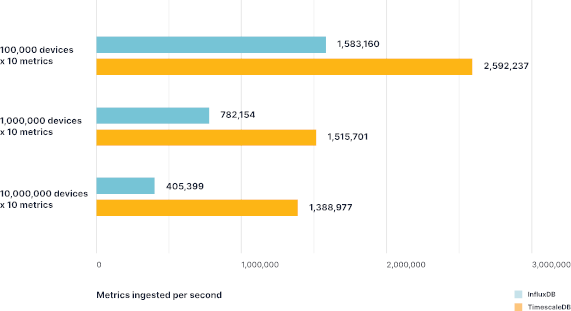
Scaling timeseries data is a painful endeavor, and one we’ve had to deal with since the early days of Sonar. In this post, I’ll walk you through some of the failures and successes we’ve had, and what we’re currently doing to support the growth we’re seeing.
What is timeseries data?
Timeseries data is a set of data points indexed in time order. We utilize timeseries data heavily in Sonar for network monitoring and bandwidth usage monitoring, as these are both situations where you are always going to view the data ordered by time.
Generally, this type of data is stored in a special type of database that’s optimized for writing and reading data structured in this way. An early platform used was RRDTool – back in the day, this was the defacto standard. It was simple to deploy, as it created files on the filesystem for every device and group of data points, and it came with built in graph generation tools.
As time went on, this became unscalable, and many new options began to crop up. Prometheus was an early option, along with Graphite and OpenTSDB, amongst many others. Many of these systems solved the same kind of needs, but in slightly different ways.
Sonar’s history with timeseries data
In Sonar v1, we decided to use InfluxDB. This was a great option early on – it was much more performant than many of the other options available, and it was fairly easy to deploy. However, as time went on, we ran into a number of issues with InfluxDB.
First, InfluxDB uses a proprietary query language. While this is not that uncommon in timeseries databases, it is painful in many scenarios, as developers have to learn a different query language, and you have to hope that the tooling available for your programming language(s) of choice is well built, or you have to build your own.
Secondly, InfluxDB’s big weakness is high series cardinality. Series cardinality is the number of different ways data can be represented – in InfluxDB, this is done using a concept of tags. For example, assume that an InfluxDB bucket has one measurement. The single measurement has two tag keys: email and status. If there are three different emails, and each email address is associated with two different statuses, the series cardinality for the measurement is 6 (3 × 2 = 6).
For our use cases, high series cardinality is very hard to escape from. We are collecting monitoring data from many devices, each with a unique ID, associated with a particular customer, each with their own unique ID, and from many different SNMP OIDs (each with their own unique OID.) When collecting data over a rapid time frame, this means the quantity of data grows extremely quickly, and the cardinality increases very rapidly. We spent a lot of time trying to optimize InfluxDB for this use case, but it was extremely challenging, and when we started on Sonar v2, we decided to look for another platform. While InfluxDB 2.0 was on the horizon, and it looked to potentially have some options to make this easier, we didn’t have time to wait.
How Sonar handles timeseries data today
After a lot of evaluation and testing, we decided to use TimescaleDB. TimescaleDB was a very exciting option for us for a few reasons. One is that it’s built on top of PostgreSQL, which is the underlying relational database we use for most purposes at Sonar. Secondly, all queries can be expressed as normal SQL queries, with the addition of some custom functions from TimescaleDB. This means all our existing SQL knowledge applies to TimescaleDB, and all our existing tooling is compatible with TimescaleDB. Lastly, in our testing, TimescaleDB was extremely performant, especially for our use cases in comparison to InfluxDB, and this led to the decision to move forward with this platform.

Still, even with a very performant platform, scaling timeseries data is tough. The ingestion rate for data across our entire customer base is huge – we can be bringing in millions of rows of data every minute, and without management, the data grows to an unmanageable level very quickly. Here’s how we’ve handled it!
Scaling TimescaleDB
Storage
A place you can quickly run into issues with timeseries data is by exceeding the capabilities of the underlying hardware you’re running the database on. Because so much data is being read and written so rapidly, the performance of the storage is very important.
Thankfully, because TimescaleDB is built on PostgreSQL, we were able to utilize tablespaces to separate data across multiple drives. TimescaleDB has a built in function called attach_tablespace which allows you to connect a TimescaleDB hypertable to a particular tablespace. In practice, this allowed us to separate each table we were using to a dedicated SSD, which greatly improved performance. The benefit of this approach is that we can continue to separate this out at a more granular level if needed – for example, if we had a particularly large customer that was consuming a lot of throughput, we could assign them to a dedicated disk or series of disks. We run our infrastructure in Microsoft Azure, and adding new disks on the fly is extremely simple and quick.

Workers & Actions
TimescaleDB allows you to register actions. An action is simply a PostgreSQL stored procedure that is run on a particular interval, and we use these heavily to downsample data (more on that shortly.) However, each time an action runs, it needs a background worker to be able to execute it, and if you have a lot of actions and/or databases, you can quickly exceed the available workers. You can use the timescaledb-tune tool to automatically tune your database configuration based on the hardware you’re running on, but you may find you need to increase the worker count beyond the default configuration. The recommended configuration is one worker per CPU core, but depending on your CPU and the complexity of the actions you’re performing, you can get away with increasing this. We skew our TimescaleDB servers towards having more cores so that we can run more workers, in comparison to our PostgreSQL servers that are more heavily skewed towards RAM.
We use actions heavily to downsample and compress data. Because we allow Sonar users to ingest data at pretty much any rate they desire, we see a lot of inbound data. This can also make queries extremely slow – even with efficient indexing, when you’re trying to query data across hundreds of millions or billions of rows, the response can be very slow. It’s also difficult to mentally parse this data – often, when you’re looking at very recent data, very high granularity is important, but if you want to look at data from months ago, it’s frequently less important. We have found that we haven’t had to downsample data that heavily to improve performance and reduce storage size to a manageable level. Here’s an example of a stored procedure we use to downsample data usage data.
Splitting this out into manageable chunks, this procedure does the following:
We now loop through each of those chunks, and create a temporary table by appending tmp to the end of the existing name. Once that’s done, we use the TimescaleDB time_bucket function to group the data into 15 minute increments. Because this is counter based data, we use the max() function to grab the largest value in the window. This data is then written into the temporary table.
We then delete the original chunk, copy our newly downsampled data back into the old chunk, and drop the temp table.
Finally, we reorder the chunk for efficiency, before compressing it using the built in TimescaleDB compression function.
We run similar actions on the other tables we have, and the performance increase and storage size decrease is huge. For a database that had swelled to 1TB for a single customer, these actions allowed us to bring the database down to less than 200GB, and decrease query resolution time on large tables from 30 seconds to less than 3 seconds. Additional downsampling would provide additional performance boosts, but we’re still evaluating the best levels to use, and trying to keep granularity as high as possible.




